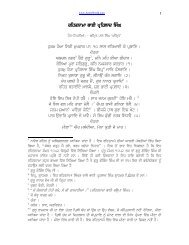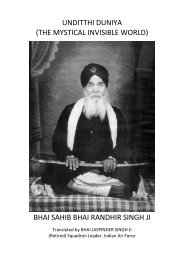Guru Gobind Singh's Death at Nanded Examination of - Vidhia.com
Guru Gobind Singh's Death at Nanded Examination of - Vidhia.com
Guru Gobind Singh's Death at Nanded Examination of - Vidhia.com
You also want an ePaper? Increase the reach of your titles
YUMPU automatically turns print PDFs into web optimized ePapers that Google loves.
46 AN EXAMINATION OF SUCCESSION THEORIES<br />
more money, for the renov<strong>at</strong>ion and construction <strong>of</strong> buildings<br />
<strong>of</strong> the Sach-khand gurdwara there. [Also see ibid., Ill, iii, 77,<br />
187, 267, 455.]<br />
R<strong>at</strong>an Chand Bal, the author <strong>of</strong> the Khdlis Ndmdh<br />
(1846 A. D., p. 13-14a) and Ganesh Das Badehra <strong>of</strong> the<br />
Char Bdgh-i-Panjdb (1855 A.D., p. 118) also confirm the inform<strong>at</strong>ion<br />
about the de<strong>at</strong>h <strong>of</strong> the <strong>Guru</strong>. [Appendix XVIII, xi.]<br />
Ghualm Muhy-ud-Din alias Bute Shah in his Tdrikh-i-<br />
Panjab <strong>of</strong> 1848, (p. 206) and Mufti Ali-ud-Din in his Ibr<strong>at</strong> Ndmdh<br />
<strong>of</strong> 1854 (vol. I, p. 178) have both mentioned the de<strong>at</strong>h .<strong>of</strong> the<br />
<strong>Guru</strong> as an historical fact. Bute Shah in his abridged recension<br />
<strong>of</strong> the Tarikh-i-Panjdb (preserved in the Panjab Public Library,<br />
Lahore) has, like Lala Sohan Lai's Umd<strong>at</strong>-ut-Tawdrikh, recorded<br />
the last <strong>com</strong>mandment <strong>of</strong> the <strong>Guru</strong> regarding the Granth being<br />
the <strong>Guru</strong> after his de<strong>at</strong>h, saying th<strong>at</strong> "there is no difference<br />
between the <strong>Guru</strong> and the Granth.'''' [P. 62, Appendix XVIII,<br />
xii a,b.]<br />
The last Persian work to be referred to on the. subject<br />
is Kanhaiya Lai Hindi's Zafar Ndmdh-i-Ranjit Singh published<br />
<strong>at</strong> Lahore in 1876. In the introductory pages, he has given a<br />
sketch <strong>of</strong> the <strong>Guru</strong>s, <strong>at</strong> the end <strong>of</strong> which he says th<strong>at</strong> "<strong>Guru</strong><br />
<strong>Gobind</strong> Singh died <strong>at</strong> Abchala Nagar (<strong>Nanded</strong> in the Deccan)<br />
in 1765 Bk. and th<strong>at</strong> no one (<strong>of</strong> his diciples) succeeded him to<br />
the (throne <strong>of</strong> <strong>Guru</strong>ship). With him ended the gaddi <strong>of</strong> leadership<br />
(masnad-i-sarwari) and with him came to an end the custom<br />
<strong>of</strong> the (succession <strong>of</strong>) <strong>Guru</strong>s (shewd-i-rahbari). [P. 52, Appendix<br />
XVIII, xiii.]<br />
European writers on history are generally more objective<br />
and precise and those who have written on the Sikhs in the first<br />
half <strong>of</strong> the nineteenth century were seasoned scholars like Sir<br />
John Malcolm, the Hon'ble W.G. Osborne, Dr. W.L. M'Gregdr<br />
and Captain Joseph D.Cunningham. The last <strong>of</strong> them incurred<br />
the displeasure <strong>of</strong> the British Indian Government and lost his<br />
political appointment for his frank and honest observ<strong>at</strong>ions in<br />
his History <strong>of</strong> the Sikhs. All <strong>of</strong> them had been in close contact<br />
with the Sikhs in the Panjab and may be safely relied upon for<br />
.their inform<strong>at</strong>ion on the historicity <strong>of</strong> <strong>Guru</strong> <strong>Gobind</strong> <strong>Singh's</strong><br />
r<br />
GURU GOBIND SINGH S DEATH AT NANDED 47<br />
de<strong>at</strong>h, <strong>of</strong> his being the tenth and the last <strong>Guru</strong> <strong>of</strong> the Sikhs<br />
and <strong>of</strong> his declar<strong>at</strong>ion and <strong>com</strong>mandment regarding <strong>Guru</strong><br />
Granth Sahib being the <strong>Guru</strong> after him. We would, therefore,<br />
quote here only the relevant passages from their works without<br />
going into any particulars about them, following only the<br />
chronological order <strong>of</strong> their public<strong>at</strong>ions.<br />
Malcolm, Lt.-Col., Sketch <strong>of</strong> the Sikhs, London, 1812.<br />
<strong>Guru</strong> Govind was the last acknowledged religious ruler <strong>of</strong><br />
the Sikhs. A prophecy had limited their spiritual guides to<br />
the number <strong>of</strong> ten ... [p.76].<br />
This sect, as has been before st<strong>at</strong>ed, have never admitted a<br />
spiritual leader since the de<strong>at</strong>h <strong>of</strong> <strong>Guru</strong> Govind [p. 89].<br />
Osborne, W. G., The Court and Camp <strong>of</strong> Runjeet Singh,<br />
London, 1840.<br />
The tenth and the last <strong>of</strong> 1 heir spiritual leaders was called<br />
Gooro Govind, whose plans <strong>of</strong> ambition were different from<br />
those <strong>of</strong> his predecessor Nanak [p. xiv].<br />
... We accordingly set the old Faqueer Uzeez-oodeen to work<br />
with him, and much to our s<strong>at</strong>isfaction heard, in the course<br />
<strong>of</strong> the evening, th<strong>at</strong> on his mentioning our wishes to the<br />
Maharajah, he had consulted the Granth, or sacred volume<br />
<strong>of</strong> the Sikhs, and th<strong>at</strong>, as the oracle was propitious, we might<br />
be prepared to set <strong>of</strong>f for Lahore in four days' time [p. 12].<br />
Runjeet Singh rarely undertakes any expedition <strong>of</strong> importance<br />
without consulting this holy book...[p. 122].<br />
The History <strong>of</strong> the Sikhs, 1846 (Calcutta).<br />
<strong>Guru</strong> Govind was the last acknowledged religious ruler <strong>of</strong><br />
the Sikhs. A prophecy had limited their spiritual guides to<br />
the number <strong>of</strong> ten...[p. 86].<br />
This sect, as has been before st<strong>at</strong>ed have never admitted a spiritual<br />
leader since the de<strong>at</strong>h <strong>of</strong> <strong>Guru</strong> Govind [p. 92].<br />
M'Gregor, W. L. The History <strong>of</strong> the Sikhs, London,<br />
.1846, vol.1.<br />
The wound was sewed up, and, to all appearance, healing, but<br />
' Govind was determined to die. He called for a strong bow, which<br />
he bent with all his force, and in doing so the stitches <strong>of</strong> his<br />
wound gave way, his bowels again protruded, and he died almost<br />
immedi<strong>at</strong>ely [p. 100].<br />
This event occurred in the year <strong>of</strong> the Hijera 1132, Samw<strong>at</strong> 1765,<br />
and A. D. 1708, <strong>at</strong> the city <strong>of</strong> Nadshur [<strong>Nanded</strong>], in the reign <strong>of</strong><br />
Buhadoor Shah [p. 100].




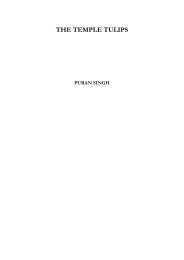
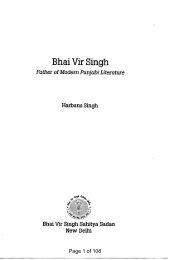

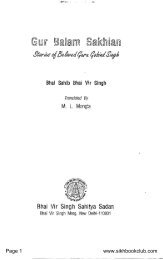
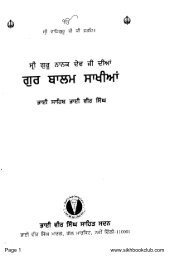
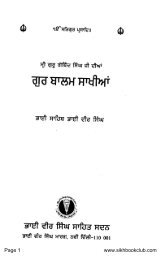
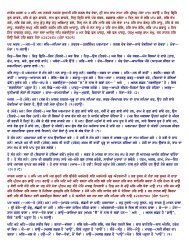
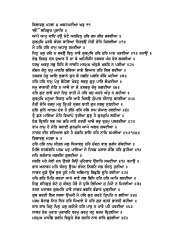

![cOpeI ] hmrI kro hwQ dY r~Cw ] pUrn hoie ic~q kI ie ... - Vidhia.com](https://img.yumpu.com/12240258/1/190x245/copei-hmri-kro-hwq-dy-rcw-purn-hoie-icq-ki-ie-vidhiacom.jpg?quality=85)
